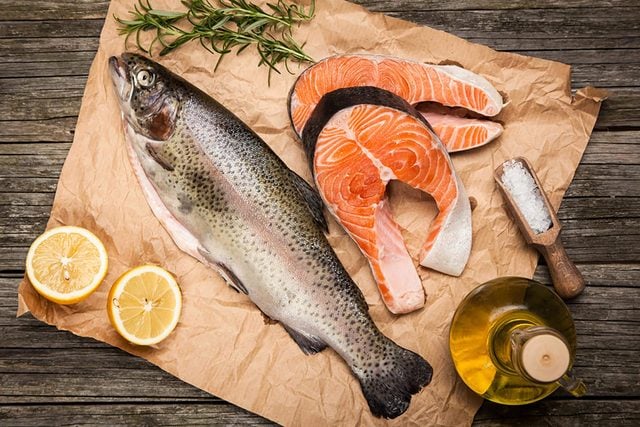Yikes! The Fish You’re Eating Could Have Live Worms In It
Updated: Mar. 29, 2021
Not to open up a can of worms, but...

Just hearing (or reading) the word “parasite” is probably enough to make your skin crawl. Seeing one in your food might just make you swear off that food forever (here’s how one bad experience with a food can make your brain have an aversion to it).
Freshly caught, wild fish is often considered a special treat, even a delicacy. And yet there’s a dark side to enjoying the catch of the day—wild fish could be infested with live worms. Tiny, parasitical worms can live inside nearly every type of wild fish, and on rare occasions, some of those creepy-crawlies make it all the way to an unfortunate diner’s plate. And this can happen regardless of how fancy the restaurant: according to Munchies, one food blogger found a trio of worms in her leftovers from a well-reviewed Portland restaurant.
The truth of the matter is that every type of wild fish is susceptible to parasites while swimming out in the ocean or rivers. The worms are called nematodes, and they live inside fish and marine mammals like dolphins. Aside from just being, well, disgusting, these parasites can also present a real health hazard in the form of nematode infection. While not deadly, this gastrointestinal infection can cause upset stomach, nausea, and diarrhea. Instances of this happening, however, are incredibly rare. Of the total 20,000 cases reported per year, an overwhelming majority are in Japan and only about 60 are in the United States. Here are some myths about food poisoning you can safely ignore.
And there’s also some consolation in the knowledge that most fish chefs do take precautions to make sure that their fish is worm-free. An X-ray technique called “candling” allows them to see, and then remove, any lurking parasites. Freezing the fish will also kill the critters—so will heating it up to a temperature of 145 degrees Fahrenheit. However, many chefs are reluctant to do this, since temperatures that high can dry out the fish and leach out some of its flavor. It’s comparable to a well-done hamburger.
The only way to completely avoid the risk is to avoid eating wild fish. According to Munchies, farming fish keeps them in a parasite-free environment that is simply impossible to achieve in the wild. However, eating farmed fish does have other drawbacks—the fish may be treated with antibiotics, and it’s simply less healthy—plus, many a fish connoisseur will claim that it just doesn’t taste as good. Here’s why you should always stay informed about where your farmed fish comes from.
So how to handle such fishy news? Well, it’s really up to you. One anonymous fish purveyor says he stays away from raw fish, which is more likely to contain the parasites. “I don’t eat sushi anymore,” he told Munchies. On the other hand, though, executive chef and culinary developer Paul Repetti claims that the threat of parasites “has never stopped [him] from eating fish.” He believes that the possibility of encountering a parasite is just an unpleasant, but rare, side effect of eating things that used to be alive. (Here are some more benefits of giving up eating animals.) “I…have never been infected by parasites and I frequently eat sushi,” he told Reader’s Digest. “Not saying that it can’t happen, but it’s very unlikely, especially since most fish used in sushi has been deep frozen at some point before consumption.”
At the end of the day, it’s a matter of choice—it’s comparable to the knowledge that eating raw or undercooked meats can cause foodborne illnesses, a warning squeezed in tiny print on many a menu. It’s up to you to decide whether enjoying the catch of the day is worth the risk. However, you should probably avoid ordering these 8 types of fish at a restaurant.
[Sources: Munchies, Spoon University, FAO Corporate Document Repository]
